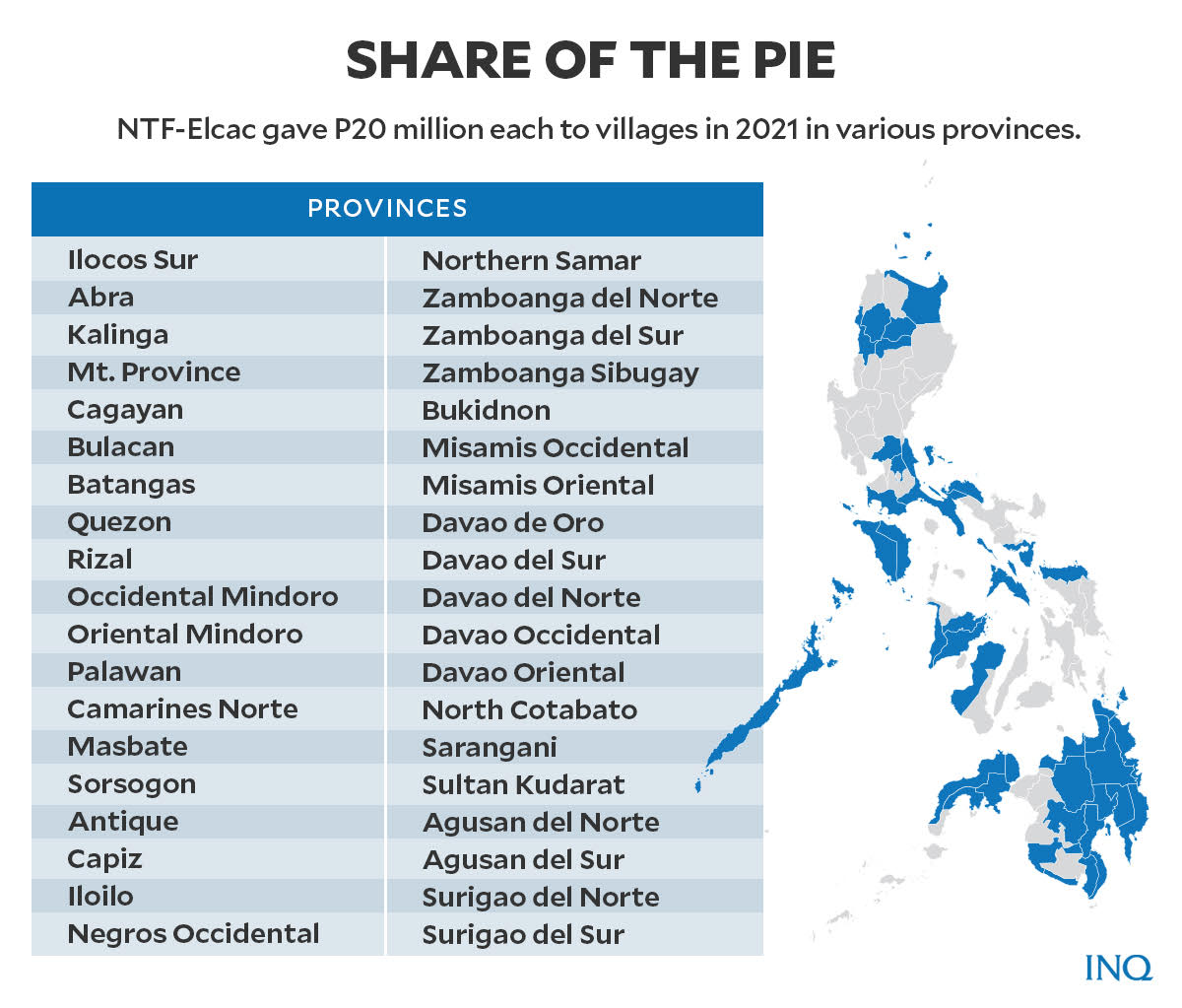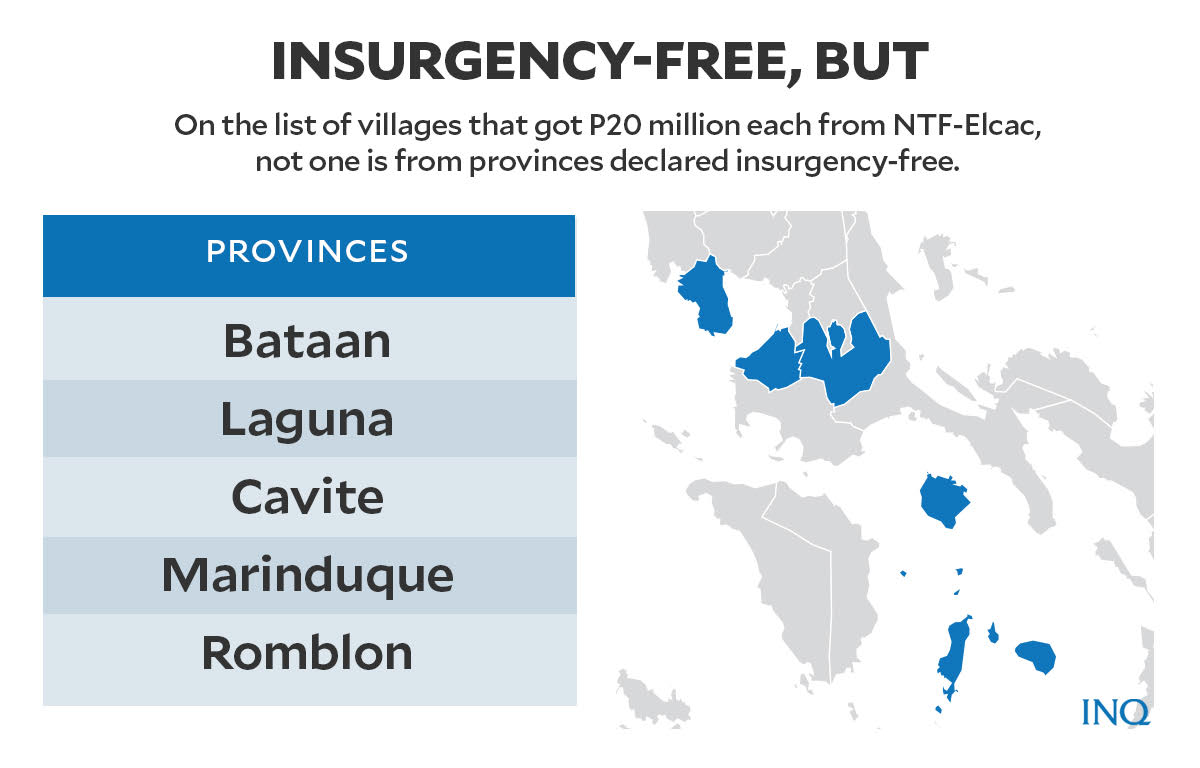As NTF-Elcac budget grows, lawmakers start to frown
MANILA, Philippines—The National Task Force to End Local Communist Armed Conflict (NTF-Elcac), the government’s weapon against a decades-old insurgency, could be losing its luster among some lawmakers who are now frowning upon its P29.2 billion proposed budget for 2022, an election year.
READ: Makabayan lawmaker vows to block NTF-Elcac 2022 budget
Sen. Panfilo Lacson, who had been supportive of the task force as a means to fight the insurgency, said on Thursday (Sept. 9) that the proposed budget for NTF-Elcac—P28.12 billion for the Barangay Development Program (BDP) and P1.08 billion allocated through the Department of the Interior and Local Government (DILG)—is a “bit too much.”
READ: Lacson regrets backing NTF-Elcac funds: ‘Merong favoritism’
Established in 2018 by President Rodrigo Duterte’s Executive Order No. 70 to provide a “whole-of-nation” approach against insurgency, the NTF-Elcac received P1.7 billion in 2020 and P19.2 billion in 2021—P16.44 billion of which was for the BDP.

Graphic by Ed Lustan
Lacson, who is running for president in 2022, expressed the same sentiments as other legislators—from the Senate and House of Representatives—over the increasing budget of the task force.
In the last week of August, following Malacañang’s defense that terrorism and rebellion will remain a threat in the midst of the health crisis, lawmakers said they will oppose the budget increase.
Article continues after this advertisementGabriela Rep. Arlene Brosas said she saw the funds as an “election war chest.”
Article continues after this advertisement“The question is this: We will be allocating P28.1 billion as NTF-Elcac fund again with the President having the discretion on where resources will be given?” Brosas said.
“This is a warchest for the election because where will they give the resources? To those who are favoring them, to those allied with them,” she said in an ANC interview.
She said the NTF-Elcac budget was considered as special purpose funds (SPF) or appropriations for offices that had not been identified when the national budget was still being prepared.
What is “cleared”?
Brosas asked why the government, specifically the DILG, is not giving details of how it identifies if a village is cleared from insurgency which makes it eligible for the NTF-Elcac’s funding.
Through the Local Government Support Fund-Support to Barangay Development Program, villages “cleared from communist terrorist groups” will receive P20 million each.
Brosas, however, said the DILG definition of a village cleared of insurgency is one which was declared as such by the governor, mayor and NTF-Elcac.
READ: Lawmakers say P 28-B gov’t fund for barangays ‘pork barrel,’ too
“They are the ones giving P20 million, they are the ones providing mechanisms, and they are the ones identifying if a village is ‘cleared’ or not,” said Brosas.
“There should be a requirement and an assurance so that people will know what cleared barangays means,” she said.
On its 2021 BDP list, the NTF-Elcac identified 822 villages as beneficiaries of P20 million each for development programs. The villages are from these 38 provinces, according to a circular of the Department of Budget and Management (DBM):

Graphic by Ed Lustan
Ilocos Sur
Abra
Kalinga
Mt. Province
Cagayan
Bulacan
Batangas
Quezon
Rizal
Occidental Mindoro
Oriental Mindoro
Palawan
Camarines Norte
Masbate
Sorsogon
Antique
Capiz
Iloilo
Negros Occidental
Northern Samar
Zamboanga del Norte
Zamboanga del Sur
Zamboanga Sibugay
Bukidnon
Misamis Occidental
Misamis Oriental
Davao de Oro
Davao del Sur
Davao del Norte
Davao Occidental
Davao Oriental
North Cotabato
Sarangani
Sultan Kudarat
Agusan del Norte
Agusan del Sur
Surigao del Norte
Surigao del Sur
A closer look, however, showed that on the 2021 list of villages that would get P20 million each under the BDP, not a single village was from provinces declared free of the insurgency in previous years—Bataan, Laguna, Cavite, Marinduque and Romblon.

Graphic by Ed Lustan
A 2019 Philippine News Agency report said that Laguna (Sept. 27, 2019), Cavite (Dec. 4, 2018), Marinduque (March 25, 2019), and Romblon (Feb. 21, 2019) were declared insurgency-free following the military and government declaration and signing of documents describing these areas as having “stable internal peace and security.”
It was on March 9, 2018 when Bataan, especially the “insurgency hotbed” of Samal, was declared by Gov. Albert Garcia free from the presence of rebels, saying that it was because of the efforts of the military, the police and other law enforcement offices.
Bayan Muna Rep. Ferdinand Gaite told INQUIRER.net that it should be asked why villages in provinces declared insurgency-free were not on the list of BDP recipients.
“Why? Isn’t being insurgency free the requirement for the BDP? It begs this question: How do they mark an area insurgency free? Does this involve dismantling legitimate people’s organizations?” he said.
INQUIRER.net reported in July that BDP funds, worth P9.7 billion, were poured by the government into regions—Davao Region, Northern Mindanao, Western Visayas, Caraga Region and Soccsksargen—with most cases of rights violations, especially of activists’ killing.
READ: P9.7B for ‘NPA-free’ villages pouring in regions with most EJKs
Last July 5, the NTF-Elcac said it wants P47 billion in 2022 for the BDP, explaining that it will cover villages “freed by the military” from 2011 to 2015.
But Marco Valbuena, information officer of the Communist Party of the Philippines, said it was clear that the NTF-Elcac is merely “overstretching their so-called achievements in the hope of being rewarded with billions of military pork barrel funds.”
INQUIRER.net tried to reach Local Government Undersecretary Jonathan Malaya, spokesperson of the NTF-Elcac, but there has been no response.
Misplaced priorities
Sen. Nancy Binay also criticized the increase in NTF-Elcac funding, comparing it to the budget of Research Institute for Tropical Medicine (RITM) which was slashed by P170 million for 2022.
RITM is the Philippines’ primary COVID-19 testing center but got only P223 million—lower than P393 million for 2021—in the Department of Health’s (DOH) P242.22 billion proposed budget in 2022.
“What’s happening? Our enemy is COVID-19. Is the [NTF-] Elcac more important than RITM? It does not make sense. Government seems to be removed from the realities on the ground,” Binay said last Aug. 25.
In the midst of an increase in COVID-19 cases in the country, the DOH was given only P19.6 billion for health crisis response—lower than the P73.9 billion it initially requested—while the NTF-Elcac has a budget of P29.2 billion.
Last Sept. 2, Health Secretary Francisco Duque III said the DOH needed P50.4 billion for health workers’ benefits in 2022, but such was excluded by the DBM from the DOH’s proposed budget.
Former Vice President Jejomar Binay likewise assailed the government for the decrease in funding for the University of the Philippines (UP)-Philippine General Hospital (PGH), saying that there is no way to defend the cut.
“In the proposed 2022 budget, PGH was allotted P5.67 billion, lower than the P6.87 billion for this year,” he said.
READ: Ex-VP Binay says cutting PGH budget amid pandemic is unjustifiable
The PGH, the main referral hospital for COVID-19 patients, and the Philippine Genome Center, the lead in the bio-surveillance for genome sequencing of COVID-19 variants, both belong to UP, a prime educational institution which faces a possible P1.3 billion slash.
Malacañang also has no provision for the hospitalization of soldiers and veterans and medical equipment in 2022, PBA Rep. Jericho Nograles said.
“I could not understand why there is zero budget for hospitalization expenses and new equipment for any of the hospitals for soldiers and veterans,” he said.
“With the resources, I hope we will not forget those defending us. They are not bulletproof, they are not COVID-proof, and we are bound by the Constitution to help and honor them,” Nograles added.
He cited the case of the Veterans Memorial Medical Center which sought P455 million for medical equipment which was scrapped by the DBM. For 2021, the Department of National Defense has P1.79 billion for hospitalization and equipment, including for reservists.
The Department of Science and Technology’s (DOST) P24.34 billion proposed budget in 2022 is P850 million, lower than its P25.19 billion in 2021. Its secretary, Fortunato dela Peña said the cut may impact the modernization of the Philippine Atmospheric Geophysical and Astronomical Services Administration (PAGASA).
PAGASA’s budget, mostly intended for infrastructure improvements, was slashed from P1.8 billion in 2021 to P1.3 billion in 2022.
‘Hard to audit’
While several lawmakers want the Commission on Audit (COA) to take a closer look at how NTF-Elcac funds are being spent, its finances are hard to track as these are coursed through various offices implementing programs against rebels while some of its resources are considered “intelligence and confidential.”
READ: Special audit of anti-communist task force funds sought
Because the use of “intelligence and confidential” funds may not be disclosed to the public, the COA relies on what the offices submit.
Despite NTF-Elcac resources being hard to trace, the COA, in its 2020 reports, called out government offices for irregularities linked to the task force.
The Technical Education and Skills Development Authority (TESDA) was called out for what the COA described as “highly questionable” spending of resources worth P160.08 million for the NTF-Elcac programs.
The COA said the funds were transferred from the central office to regional offices, but lacked authority and guidelines which exposed the funds to misuse.
TESDA Director General Isidro Lapeña explained that the amount was used for scholarships and livelihood programs.
The COA also called out the National Commission for Indigenous Peoples (NCIP), the office led by its chair, Allen Capuyan.
The COA said P1.06 million worth of meals and accommodations at the NCIP office in Caraga Region for NTF-Elcac Regional Action Planning Workshop were not backed with sufficient documentation “casting doubts on the propriety and regularity of the transaction.”
The Office of the Presidential Adviser on the Peace Process likewise lacked supporting documents for its expenses worth P1.36 million for the NTF-Elcac.
“Various vouchers and their corresponding supporting documents pertaining to the Elcac fund for CY 2019 were not submitted to the Office of the Auditor, contrary to Paragraph 6.05 of COA Circular No. 95-006 dated May 18, 1995,” COA said in its report.
The DILG’s office in Central Mindanao was also called out by the COA for deficiencies involving P5 million worth of NTF-Elcac funds coursed through DILG, including P2.92 million worth of “unliquidated fund transfers to field offices.”
The DILG explained that the amount was not a fund transfer, but a downloading of funds to the DILG field office for the implementation of DILG programs in the barangays.
Lacson also said a police general is allegedly using a portion of NTF-Elcac resources to survey 30 percent of villages’ population.
READ: Lacson: Police general instructing ‘census’ in barangays using anti-insurgency funds
He said he received reports that the Philippine National Police’s (PNP) share of P800 million in the NTF-Elcac fund as a member agency is being used to conduct a “census,” but the PNP denied the claim.
